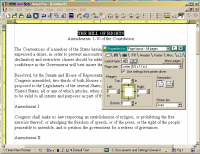Indholdsfortegnelse
 Lotus Software (der hed Lotus Development Corporation før det blev overtaget af IBM) er et amerikansk software firma med hjemsted i Cambridge, Massachusetts. Lotus er mest kendt for dets nyskabende Lotus 1-2-3 regnearks program, der var den første såkaldte killer app fra IBM PC'ens tidligste dage og som understøttede PC'ens udbredelse. Med hjælp fra Ray Ozzie fra Iris Associates, udviklede de også et af de stærkere groupwaresystemer, Lotus Notes. IBM købte selskabet i 1995 for 3.5 milliarder dollars1) primært for at få fat i Notes og for at komme ind på det stadigt vigtigere client-server marked, som hurtigt var ved at gøre de host-baserede produkter som IBM's OfficeVision, DEC's ALL-IN-1 og Wang Labs' Wang OFFICE forældede.
Lotus Software (der hed Lotus Development Corporation før det blev overtaget af IBM) er et amerikansk software firma med hjemsted i Cambridge, Massachusetts. Lotus er mest kendt for dets nyskabende Lotus 1-2-3 regnearks program, der var den første såkaldte killer app fra IBM PC'ens tidligste dage og som understøttede PC'ens udbredelse. Med hjælp fra Ray Ozzie fra Iris Associates, udviklede de også et af de stærkere groupwaresystemer, Lotus Notes. IBM købte selskabet i 1995 for 3.5 milliarder dollars1) primært for at få fat i Notes og for at komme ind på det stadigt vigtigere client-server marked, som hurtigt var ved at gøre de host-baserede produkter som IBM's OfficeVision, DEC's ALL-IN-1 og Wang Labs' Wang OFFICE forældede.
Tidlig historie
Lotus blev grundlagt i 1982 af partnerne Mitch Kapor og Jonathan Sachs med støtte fra Ben Rosen. Lotus' første produkt var præsentationssoftware til Apple II kendt som Lotus Executive Briefing System. Mitch grundlagde Lotus efter at have arbejdet som leder af udvikligen ved VisiCorp (the marketers of VisiCalc) and selling the rights to his products; VisiPlot and VisiTrend to VisiCorp.
Shortly after Kapor left VisiCorp, he and Sachs produced an integrated spreadsheet and graphing program. Even though IBM and VisiCorp collaborated on VisiCalc for the PC and VisiCalc shipped simultaneously with the PC, Lotus had a superior product. Lotus released Lotus 1-2-3 in January 1983. The name referred to the three ways the product could be used, as a spreadsheet, graphics package, and database manager.In fact the latter two functions were less often used, and 1-2-3 was the most powerful spreadsheet available. Sales were huge, turning Lotus into the largest independent software vendor in the world almost overnight. The business plan had called for $1 million in sales in the first year, and the actual results were $54 million.
In 1982 Jim Manzi came to Lotus as a management consultant, and became an employee four months later. In October 1984 he was named President, and in April 1986 he was named as CEO, succeeding founder Mitchell Kapor who had become inactive in the company. In July of that same year he also became Chairman of the Board. Manzi would remain at the head of Lotus until 1995.
Dominance
As the popularity of the personal computer grew, Lotus quickly came to dominate the spreadsheet market. Lotus introduced other office products such as Ray Ozzie's Symphony in 1984 and the Jazz office suite for the Apple Macintosh computer in 1985. Jazz did very poorly in the market. Also in 1985, Lotus bought Software Arts and discontinued the latter company's VisiCalc program.
In the late 1980s, Lotus developed Lotus Magellan, a file management and indexing utility. This period also saw the release of Manuscript, a word processor, Lotus Agenda, an innovative personal information manager (PIM), which flopped, and Improv, a groundbreaking modeling package for the NeXT platform. Improv also flopped, and none of these products made a significant impact on the market.
Diversification
In the 1990s, to compete with Microsoft's Windows applications, Lotus had to buy in products such as Freelance Graphics, Ami Pro (word processor), Approach (database), and Threadz, which became Lotus Organizer. Several of the these (1-2-3, Freelance Graphics, Ami Pro, Approach, and Lotus Organizer) were bundled together under the name Lotus SmartSuite. Although SmartSuite was bundled cheaply with many PCs and may initially have been more popular than Microsoft Office, Lotus quickly lost its dominance in the desktop applications market with the transition to 32 bit applications running on Windows 95. Lotus was late in delivering its suite of 32 bit products and failed to capitalize on the transition to the new version of Windows. It now has very little market share. The last significant new release was the SmartSuite Millennium Edition released in 1999. All new development of the suite was ended in 2000 with ongoing maintenance being shifted overseas.
Lotus began its diversification from the desktop software business with its 1984 strategic founding investment in Ray Ozzie's Iris Associates, the creator of its Lotus Notes groupware platform. As a result of this early speculative move, Lotus had gained significant experience in network-based communications years before other competitors in the PC world had even started thinking about networked computing or the Internet. Lotus initially brought Notes to market in 1989, and later reinforced its market presence with the acquisition of Mail in 1991. In 1994, Lotus acquired Iris Associates. Lotus's dominant groupware position attracted IBM, which needed to make a strategic move away from host-based messaging products and to establish a stronger presence in client-server computing, but it also soon attracted stiff competition from Microsoft Exchange.
Look and Feel
Lotus was involved in a number of lawsuits, of which the most significant were the „look and feel“ cases which started in 1987. Lotus sued Paperback Software and Mosaic for copyright infringement, false and misleading advertising, and unfair competition over their low-cost clones of 1-2-3, VP Planner and Twin, and sued Borland over its Quattro spreadsheet. This led Richard Stallman, founder of the Free Software Foundation, to found the League for Programming Freedom (LPF) and hold protests outside Lotus Development offices. Paperback and Mosaic lost and went out of business; Borland won and survived. The LPF filed an amicus curiae brief [http://www-swiss.ai.mit.edu/6805/articles/int-prop/lotus/lpf-amicus2.txt] in the Borland case.
In the spring of 1995 IBM launched a hostile bid for Lotus with a $60-per-share tender offer, when Lotus' stock was only trading at $32. Jim Manzi looked for potential white knights, and forced IBM to increase its bid to $64.50 per share, for a $3.5 billion buyout of Lotus in July 1995.[http://www.crn.com/sections/special/hof/hof03.jhtml;?articleId=18825870&_requestid=226714] On October 11, 1995 Manzi announced his resignation from Lotus (by then known as the Lotus Development division of IBM). He left with stock worth $78 million.
Rumors
It has been repeatedly alleged that in 1997 the NSA had backdoored the export version of Notes, but this is a mis-characterization of what actually happened. Prior to that year, Lotus had been restricted from exporting software that used encryption keys that were longer than 40 bits by United States law. Under an agreement with the US government, Lotus was allowed to start exporting 64 bit keys, so long as 24 bits of each key were recoverable using a special key issued by Lotus to the NSA. The result was that the newer version of Lotus Notes provided stronger protection against industrial espionage than any previous version had been allowed to provide, and it provided no less protection against decryption by the NSA than the previous versions had given. (US export regulations were changed in 2001, so current versions of Lotus products are able to use longer keys and they no longer provide NSA with access to any key bits.)
Corporate culture
 Following in founder Mitch Kapor's footsteps, Lotus has always had a reputation as a progressive company. Lotus's first employee was Janet Axelrod who created not only the Human Resources organization but was the central figure in creating the much respected Lotus culture. As she continued to build her organization and play a central role with the senior management, she eventually hired Freada Klein as the first Director of Employee Relations to help with her emphasis on ensuring a fair workplace. In 1986, Lotus was the first major company to support an AIDS walk. In 1990, Lotus opened a daycare center for the children of its employees. In 1992, Lotus was the first major company to offer full benefits to same-sex partners. In 1998, Lotus was named one of the Top 10 best companies to work for working mothers by
Following in founder Mitch Kapor's footsteps, Lotus has always had a reputation as a progressive company. Lotus's first employee was Janet Axelrod who created not only the Human Resources organization but was the central figure in creating the much respected Lotus culture. As she continued to build her organization and play a central role with the senior management, she eventually hired Freada Klein as the first Director of Employee Relations to help with her emphasis on ensuring a fair workplace. In 1986, Lotus was the first major company to support an AIDS walk. In 1990, Lotus opened a daycare center for the children of its employees. In 1992, Lotus was the first major company to offer full benefits to same-sex partners. In 1998, Lotus was named one of the Top 10 best companies to work for working mothers by Working Mother magazine.
In 1995, Lotus had over 4,000 employees worldwide and IBM's acquisition of Lotus was greeted with apprehension by many Lotus employees, who feared that the corporate culture of „Big Blue“ would smother their creativity. To the surprise of many employees and journalists, IBM adopted a very hands-off, laissez-faire attitude towards its new acquisition.
However, by the year 2000, the inevitable assimilation of Lotus was almost complete. While the mass employee defections that IBM feared did not materialize, many long-time Lotus employees did complain about the transition to IBM's culture (IBM's employee benefits programs, in particular, were singled out as inferior to Lotus's very progressive programs).
Lotus's headquarters in Cambridge used to be divided into two buildings, the Lotus Development Building (LDB) (on the banks of the Charles River) and the Rogers Street building, located adjacent to the CambridgeSide Galleria. However, in 2001, then President and General Manager, Al Zollar decided not to renew the lease of LDB. The subsequent migration of employees across the street (and into home offices) generally coincided with what was probably the final exodus of employees from the company.
The integration of Lotus into IBM continues. Today, it is a software brand in IBM's Software Group. Within Lotus, there is still a strong sense of unity. Many former Lotus employees, though they have moved into and embraced IBM, still identify with Lotus and see themselves as part of the Lotus community.
Origins
Mitch Kapor got the name for his company from 'The Lotus Position' or 'Padmasana'. Kapor used to be a teacher of Transcendental Meditation technique as taught by Maharishi Mahesh Yogi. Incidentally, competitor Borland code-named their Quattro Pro software „Buddha“, as the software was meant to „assume the Lotus position“ and take over Lotus 1-2-3's market. There also was (circa 1995) the assertion by one Lotus cc: Mail employee that „Quattro Pro“ was taken from the Spanish word „cuatro“, or number four. Thus, „Uno-Dos-Tres-Cuatro“ was a spin/play on Lotus 1-2-3. date=February 2007
See also
- [http://www.ibm.com/software/sw-lotus/products/product1.nsf/wdocs/expeditor IBM Lotus Expeditor] (formerly IBM WebSphere Everyplace Deployment) - Complete end to end platform enabling OSGi developers to build configurable, disconnectable, managed, applications and services for desktop, mobile, and embeddable clients delivering web, ajax, and/or rich user interfaces
External links
- [http://www.ibm.com/software/lotus Official website]
- [http://www-8.ibm.com/software/au/lotus Lotus Software Australia]
- [http://www.axle.org AXLE, the Association of ex-Lotus Employees]
- [ftp://ftp.lotus.com/pub/lotusweb/product/smartsuite/Kvlotus.exe Free viewer for Lotus SmartSuite products (EXE)]
- [http://www.ibm.com/developerworks/lotus/library/expeditor-osgi-services/ Developing an OSGi service as a Web service in IBM Lotus Expeditor]
- [http://www.redbooks.ibm.com/redpieces/abstracts/SG247367.html?Open „Building Composite Applications“ by IBM covers the architecture, available tools, component considerations, assembling, deploying and wiring components in WebSphere Portal and Rich Client Platforms such as Lotus Expeditor and Lotus Notes 8 which are based on OSGi technology.]